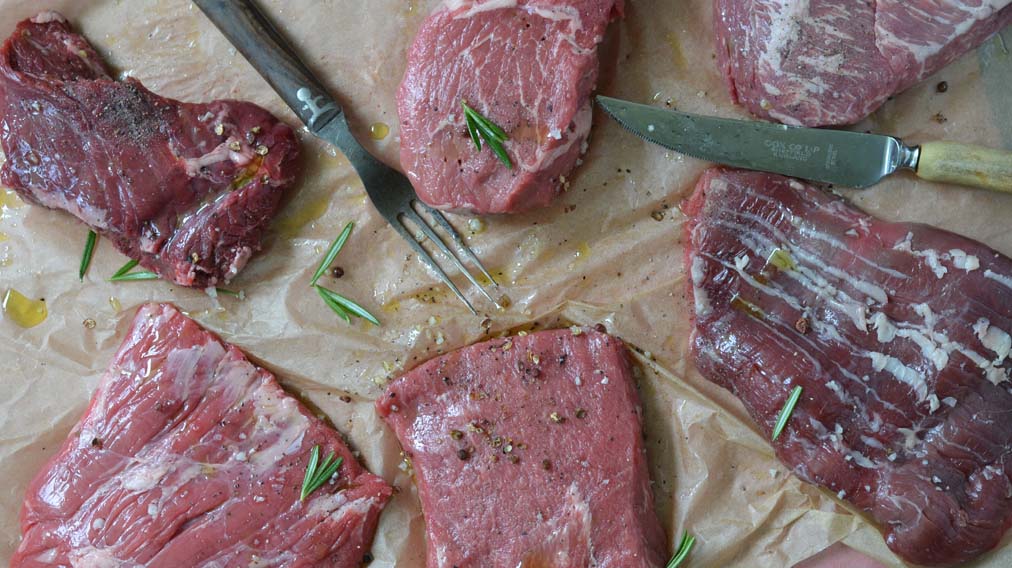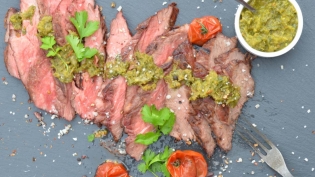The Unsung Heroes of the Grill
Cooking a nice big, juicy steak over a grill has become a summertime right of passage. Standing over hot flames on a warm night with a cold beverage is as much a social function as it is a way to cook our food.
When we think of throwing steaks on the grill, our minds drift to the powerhouses — favourites such as the tenderloin, porterhouse, New York strip or the rib-eye. While these steaks have reached such status because they are tender and tasty, they can be expensive. There are other options out there that are very flavourful, easy to cook, suit a crowd and can be easier on the pocketbook. Not found at the large grocery chains, here are a few of our favourites you can find at your local butcher or direct from the farmer:
1. The Hanger Historically, the hanger steak has been called the “butcher’s steak” as they often kept it for for themselves, being the only cut of it’s kind on the steer. This flavourful muscle comes from the diaphragm area next to the kidney, which gives the meat a stronger offal flavour. The hanger has a coarse grain and an inedible membrane running through its centre, which has to be removed. Grill this delicious cut over high heat to medium rare, slicing the meat against the grain. In France, it is commonly known as a bistro steak, served simply with frites and a mustard sauce.
2. Skirt Steak The skirt steak is the other half of the diaphragm muscle from the lower belly. The outer skirt is thicker and also contains a membrane that should be removed, while the inner skirt is thinner and well marbled. Like the hanger, it has a coarse grain and rich, beefy flavour. High heat, a short cooking time and a diagonal cut are perfect for this cut of steak. The skirt steak is traditionally the cut of beef used in fajitas as it absorbs the flavour of marinades well.
3. The Bavette In North America the bavette or flap steak is often confused with other steaks like the skirt or flank (to make matters worse, the French have several steaks named bavette). The bavette actually comes from the bottom of the short loin, an extension of the T-bone, just above the flank. This piece of meat also benefits from marinating, high, dry heat and slicing across its grain. Cook to no more than medium.
4. The Tri-tip The tri-tip is a triangular muscle that also comes from the bottom of the sirloin. The muscle is used to move the back legs of the steer. Since it is a “movement“ muscle, the tri-tip is quite lean and has been traditionally used in ground beef. In California, the tri-tip is often barbequed, long and slow over a low heat or in the smoker, though it is still best to serve at no more than a medium to medium rare. The flavour of the tri-tip is less beefy, so heavier seasoning and a more pungent sauce pair well with this cut.
5. The Flat Iron Researchers from the Universities of Nebraska and Florida found by removing a tough membrane out of the top blade roast from the shoulder (chuck) of the steer, there are a couple of well-marbled triangular pieces of meat. The flat iron steak is the second most tender muscle on the cow and has great flavour. Grill over medium high heat to medium rare.
6. The Petite Tender The petite tender is a small oblong muscle in the shoulder of the cow, near the top blade (like the flat iron), that gets it’s name from looking like a smaller version of the tenderloin. Though this is a whole muscle, it does take some expertise to remove it from the rest of the shoulder. Unlike the tenderloin, the petite tender is less forgiving to overcooking. Cook over medium high heat to no more than medium. Cook whole and cut into medallions once the meat has rested.
Grilling Tips
1. A dry surface makes a better sear. Remove your meat from its packaging, pat dry and place onto a plate before putting it in the refrigerator, uncovered for an hour or two before you are ready to cook.
If using a marinade, remove excess marinade and allow to dry.
2. Be patient. Allow plenty of time to pre-heat the grill. Get your grill good and hot, then use a brush to remove any charred bits still clinging to the grill. Now, you can adjust the heat to your preference.
3. Oil the grill. Wipe the grill with an oiled cloth to prevent your meat or vegetables from sticking.
4. Season your meat liberally just before you take it to the grill.
5. Give it a rest. Once you’ve finished cooking it to your liking, it’s important to let meat rest. The heat from the grill causes water in the meat to move upwards.
Letting the meat sit for a few minutes lets the juices redistribute, resulting in a final product that’s juicier.
Grilling Guide
Rare
Internal temperature: 120-125F Red, cool centre
For a one-inch steak, cook 7 to 8 minutes, turning once
Medium Rare
Internal temperature: 130-135F Red, warm centre
For a one-inch steak, cook 8 to 9 minutes, turning once
Medium
Internal temperature: 140-145F Pink throughout
For a one-inch steak, cook 9 to 10 minutes, turning once
Medium Well
Internal temperature: 150-155F Mostly cooked with a little pink
For a one-inch steak, cook 10 to 12 minutes, turning once
Well Done
Internal temperature: 160+ F Fully cooked
For a one-inch steak, cook 12+ minutes, turning once






